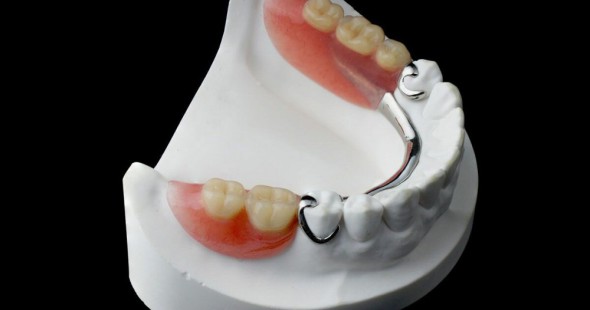Сlasp prostheses
Clasp prosthesis is a removable dental structure, due to which the chewing load is distributed not only to the supporting teeth, but also to the rest of the jaw. This is achieved through a special metal frame in the form of an arc, made of a light and strong alloy that does not affect the chewing process.
That’s why clasp prostheses are in demand by patients and orthopedic doctors they order a large number of such works.
Their durability will depend on how well these types of prostheses will be performed.
In the Dental laboratory «Cifra» all laboratory stages of clasp prosthetics are observed:
- Casting of models based on ready-made plaster impressions.
- Drawing of the frame of the clasp structure.
- Manufacturing and modeling of the frame of the clasp prosthesis.
- Casting of the frame of the structure. Grinding, polishing of the frame.
- Packing of the frame of the clasp prosthesis on the model.
- Modeling of the wax base, selection and installation of artificial teeth.
- Fitting the frame of the structure in the patient’s oral cavity. (orthopedic stage in the clinic)
- Replacement of wax with plastic, final processing of the prosthesis (polishing, grinding).
- Packing with the imposition of a clasp design.
In our work, we use several methods of manufacturing clasp structures.
- Casting of the structure with the removal of the wax blank from the model. According to this technology, the prepared wax structure is removed from the plaster model, packed in a refractory mass, wax is melted and molten metal is poured into the vacant place.
- Casting of the structure on a refractory model. The frame of an arc prosthesis is modeled on a refractory plaster model made of wax. The technique of manufacturing clasp prostheses in the second way has advantages, which are characterized by the fact that metal shrinkage is eliminated and the possibility of deformation of the wax blank of the frame is excluded when it is removed from the model for packaging in a refractory mass. The designs created by the casting method are very light and precise in manufacturing, and therefore do not require long-term habituation.
Types of clasp prosthetics:
- Dentures with clamp fixation — in this case, the fastening of the clasp prosthesis is carried out using metal hooks that are mounted on the supporting teeth.
- The dentures are clasp-type with locking on the lock. This type of prosthesis is attached to the supporting healthy teeth with the help of micro-locks. The lock itself consists of two elements, one of which is installed on the prosthesis itself, and the second is put on the crown of the supporting tooth (metal-ceramic, zirconium, etc.).
- Prostheses made using the method of bypass clasp prosthetics. The design with a thin arc fits snugly to the inside of the teeth, creating maximum immobility. Bypass prostheses are installed in cases where patients have progressive periodontal diseases.

